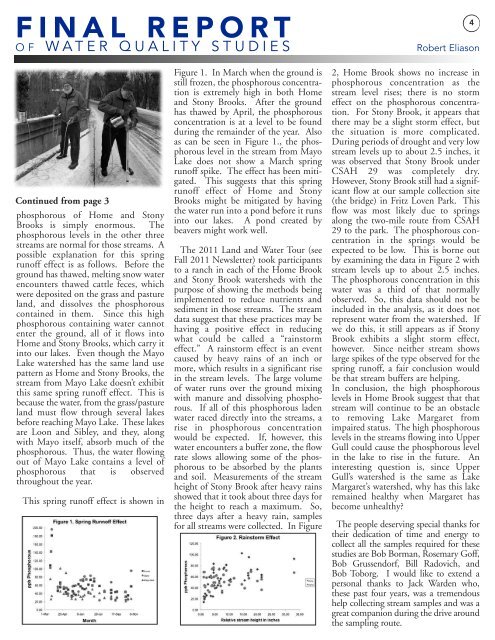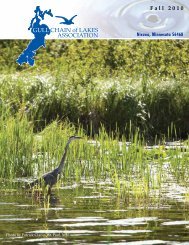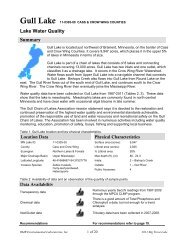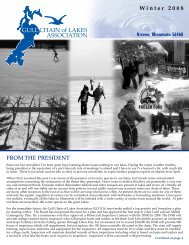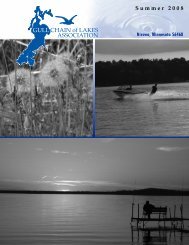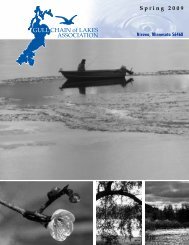Spring - Gull Chain of Lakes Association
Spring - Gull Chain of Lakes Association
Spring - Gull Chain of Lakes Association
Create successful ePaper yourself
Turn your PDF publications into a flip-book with our unique Google optimized e-Paper software.
F I N A L R E P O R T<br />
O F W A T E R Q U A L I T Y S T U D I E S Robert Eliason<br />
Continued from page 3<br />
phosphorous <strong>of</strong> Home and Stony<br />
Brooks is simply enormous. The<br />
phosphorous levels in the other three<br />
streams are normal for those streams. A<br />
possible explanation for this spring<br />
run<strong>of</strong>f effect is as follows. Before the<br />
ground has thawed, melting snow water<br />
encounters thawed cattle feces, which<br />
were deposited on the grass and pasture<br />
land, and dissolves the phosphorous<br />
contained in them. Since this high<br />
phosphorous containing water cannot<br />
enter the ground, all <strong>of</strong> it flows into<br />
Home and Stony Brooks, which carry it<br />
into our lakes. Even though the Mayo<br />
Lake watershed has the same land use<br />
pattern as Home and Stony Brooks, the<br />
stream from Mayo Lake doesn’t exhibit<br />
this same spring run<strong>of</strong>f effect. This is<br />
because the water, from the grass/pasture<br />
land must flow through several lakes<br />
before reaching Mayo Lake. These lakes<br />
are Loon and Sibley, and they, along<br />
with Mayo itself, absorb much <strong>of</strong> the<br />
phosphorous. Thus, the water flowing<br />
out <strong>of</strong> Mayo Lake contains a level <strong>of</strong><br />
phosphorous that is observed<br />
throughout the year.<br />
This spring run<strong>of</strong>f effect is shown in<br />
Figure 1. In March when the ground is<br />
still frozen, the phosphorous concentration<br />
is extremely high in both Home<br />
and Stony Brooks. After the ground<br />
has thawed by April, the phosphorous<br />
concentration is at a level to be found<br />
during the remainder <strong>of</strong> the year. Also<br />
as can be seen in Figure 1., the phosphorous<br />
level in the stream from Mayo<br />
Lake does not show a March spring<br />
run<strong>of</strong>f spike. The effect has been mitigated.<br />
This suggests that this spring<br />
run<strong>of</strong>f effect <strong>of</strong> Home and Stony<br />
Brooks might be mitigated by having<br />
the water run into a pond before it runs<br />
into our lakes. A pond created by<br />
beavers might work well.<br />
The 2011 Land and Water Tour (see<br />
Fall 2011 Newsletter) took participants<br />
to a ranch in each <strong>of</strong> the Home Brook<br />
and Stony Brook watersheds with the<br />
purpose <strong>of</strong> showing the methods being<br />
implemented to reduce nutrients and<br />
sediment in those streams. The stream<br />
data suggest that these practices may be<br />
having a positive effect in reducing<br />
what could be called a “rainstorm<br />
effect.” A rainstorm effect is an event<br />
caused by heavy rains <strong>of</strong> an inch or<br />
more, which results in a significant rise<br />
in the stream levels. The large volume<br />
<strong>of</strong> water runs over the ground mixing<br />
with manure and dissolving phosphorous.<br />
If all <strong>of</strong> this phosphorous laden<br />
water raced directly into the streams, a<br />
rise in phosphorous concentration<br />
would be expected. If, however, this<br />
water encounters a buffer zone, the flow<br />
rate slows allowing some <strong>of</strong> the phosphorous<br />
to be absorbed by the plants<br />
and soil. Measurements <strong>of</strong> the stream<br />
height <strong>of</strong> Stony Brook after heavy rains<br />
showed that it took about three days for<br />
the height to reach a maximum. So,<br />
three days after a heavy rain, samples<br />
for all streams were collected. In Figure<br />
2, Home Brook shows no increase in<br />
phosphorous concentration as the<br />
stream level rises; there is no storm<br />
effect on the phosphorous concentration.<br />
For Stony Brook, it appears that<br />
there may be a slight storm effect, but<br />
the situation is more complicated.<br />
During periods <strong>of</strong> drought and very low<br />
stream levels up to about 2.5 inches, it<br />
was observed that Stony Brook under<br />
CSAH 29 was completely dry.<br />
However, Stony Brook still had a significant<br />
flow at our sample collection site<br />
(the bridge) in Fritz Loven Park. This<br />
flow was most likely due to springs<br />
along the two-mile route from CSAH<br />
29 to the park. The phosphorous concentration<br />
in the springs would be<br />
expected to be low. This is borne out<br />
by examining the data in Figure 2 with<br />
stream levels up to about 2.5 inches.<br />
The phosphorous concentration in this<br />
water was a third <strong>of</strong> that normally<br />
observed. So, this data should not be<br />
included in the analysis, as it does not<br />
represent water from the watershed. If<br />
we do this, it still appears as if Stony<br />
Brook exhibits a slight storm effect,<br />
however. Since neither stream shows<br />
large spikes <strong>of</strong> the type observed for the<br />
spring run<strong>of</strong>f, a fair conclusion would<br />
be that stream buffers are helping.<br />
In conclusion, the high phosphorous<br />
levels in Home Brook suggest that that<br />
stream will continue to be an obstacle<br />
to removing Lake Margaret from<br />
impaired status. The high phosphorous<br />
levels in the streams flowing into Upper<br />
<strong>Gull</strong> could cause the phosphorous level<br />
in the lake to rise in the future. An<br />
interesting question is, since Upper<br />
<strong>Gull</strong>’s watershed is the same as Lake<br />
Margaret’s watershed, why has this lake<br />
remained healthy when Margaret has<br />
become unhealthy?<br />
The people deserving special thanks for<br />
their dedication <strong>of</strong> time and energy to<br />
collect all the samples required for these<br />
studies are Bob Borman, Rosemary G<strong>of</strong>f,<br />
Bob Grussendorf, Bill Radovich, and<br />
Bob Toborg. I would like to extend a<br />
personal thanks to Jack Warden who,<br />
these past four years, was a tremendous<br />
help collecting stream samples and was a<br />
great companion during the drive around<br />
the sampling route.<br />
4


